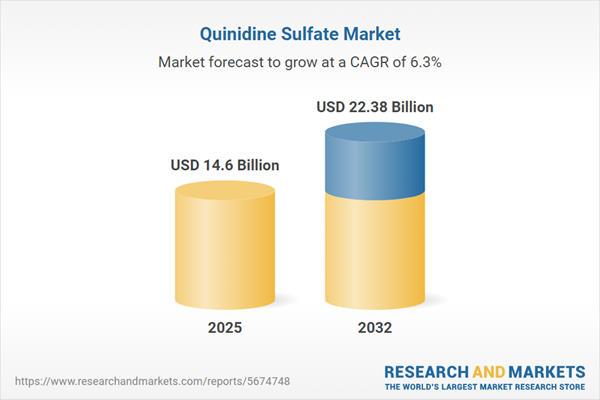Speak directly to the analyst to clarify any post sales queries you may have.
The quinidine sulfate market is rapidly evolving as pharmaceutical leaders and healthcare stakeholders adapt to new clinical, regulatory, and operational challenges. This report delivers a clear strategic overview for senior decision-makers navigating the future of quinidine sulfate across global healthcare sectors.
Market Snapshot: Quinidine Sulfate Market Overview
The quinidine sulfate market grew from USD 13.74 billion in 2024 to USD 14.60 billion in 2025. It is expected to continue expanding at a CAGR of 6.28%, reaching USD 22.38 billion by 2032. This growth is propelled by ongoing advancements in antiarrhythmic therapy, revitalized research into new dosage forms, evolving healthcare infrastructure, and increased focus on supply chain resilience.
Scope & Segmentation
- Application: Arrhythmia treatment, Malaria treatment
- Dosage Form: Capsules, Injectable, Tablets
- Distribution Channel: Hospital pharmacy, Online pharmacy, Retail pharmacy
- End User: Clinics, Home healthcare, Hospitals
- Regions Covered: Americas, Europe, Middle East & Africa, Asia-Pacific
- Countries & Notable Markets: United States, Canada, Mexico, Brazil, Argentina, Chile, Colombia, Peru, United Kingdom, Germany, France, Russia, Italy, Spain, Netherlands, Sweden, Poland, Switzerland, United Arab Emirates, Saudi Arabia, Qatar, Turkey, Israel, South Africa, Nigeria, Egypt, Kenya, China, India, Japan, Australia, South Korea, Indonesia, Thailand, Malaysia, Singapore, Taiwan
- Key Companies Profiled: Teva Pharmaceuticals International GmbH, Sandoz International GmbH, Mylan Pharmaceuticals Inc., Sun Pharmaceutical Industries Ltd., Apotex Inc., Aurobindo Pharma Ltd., Cipla Limited, Dr. Reddy's Laboratories Ltd., Hikma Pharmaceuticals PLC, Hetero Drugs Limited
Key Takeaways for Senior Decision-Makers
- Clinical innovation in antiarrhythmic therapy and broader application in drug-resistant pathogens are shaping quinidine sulfate’s growing relevance.
- Investment in advanced formulation science and patient-centric dosing platforms supports improved pharmacokinetics and patient adherence.
- Supply chain strategies are evolving, with increased emphasis on local production, diversification of suppliers, and operational resilience.
- Collaborations across academic centers and pharmaceutical companies are driving protocol refinement, particularly in combination therapies and emerging use cases.
- Market adoption patterns vary by region, influenced by healthcare infrastructure, regulatory harmonization, and value-based reimbursement models.
- Competitive dynamics are marked by global research leaders emphasizing innovation, contract manufacturers ensuring reliable supply, and regional players leveraging agility in regulatory navigation.
Tariff Impact: 2025 United States Developments
New United States tariffs on pharmaceutical imports are altering quinidine sulfate’s supply chain landscape. These policies drive reassessment of sourcing strategies, with some manufacturers boosting domestic production and others diversifying supplier networks to cushion against price volatility. Additionally, logistics optimization and advocacy for tariff exemptions have become central to maintaining affordable access and inventory stability for essential therapeutics.
Methodology & Data Sources
This report leverages a dual research framework integrating primary insights from executive and expert interviews with secondary validation from peer-reviewed literature, regulatory filings, and public databases. Key drivers and barriers were synthesized using structured analytics, supported by ongoing quality control and accuracy verification procedures.
Why This Report Matters
- Enables executives to benchmark quinidine sulfate strategies within an evolving global context by highlighting critical trends and challenges shaping procurement and market growth.
- Supports evidence-based decision-making by mapping clinical, regulatory, and operational developments relevant to expanding therapeutic portfolios.
- Offers a foundation for strategic planning through comprehensive segmentation analysis, coverage of technology advances, and a clear view of regional differentiation.
Conclusion
This analysis equips industry leaders with actionable intelligence to optimize quinidine sulfate strategies in a dynamic market. Adopting resilient supply chains, prioritized innovation, and regionally tailored approaches will be critical to navigating ongoing change and sustaining growth.
Additional Product Information:
- Purchase of this report includes 1 year online access with quarterly updates.
- This report can be updated on request. Please contact our Customer Experience team using the Ask a Question widget on our website.
Table of Contents
3. Executive Summary
4. Market Overview
7. Cumulative Impact of Artificial Intelligence 2025
Companies Mentioned
The companies profiled in this Quinidine Sulfate market report include:- Teva Pharmaceuticals International GmbH
- Sandoz International GmbH
- Mylan Pharmaceuticals Inc.
- Sun Pharmaceutical Industries Ltd.
- Apotex Inc.
- Aurobindo Pharma Ltd.
- Cipla Limited
- Dr. Reddy's Laboratories Ltd.
- Hikma Pharmaceuticals PLC
- Hetero Drugs Limited
Table Information
| Report Attribute | Details |
|---|---|
| No. of Pages | 189 |
| Published | October 2025 |
| Forecast Period | 2025 - 2032 |
| Estimated Market Value ( USD | $ 14.6 Billion |
| Forecasted Market Value ( USD | $ 22.38 Billion |
| Compound Annual Growth Rate | 6.2% |
| Regions Covered | Global |
| No. of Companies Mentioned | 11 |









